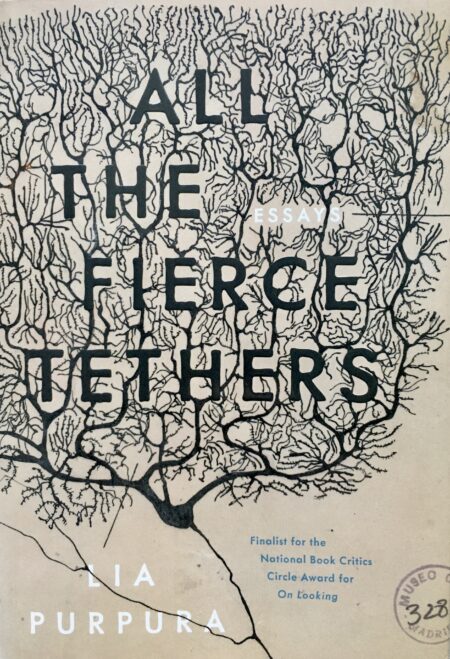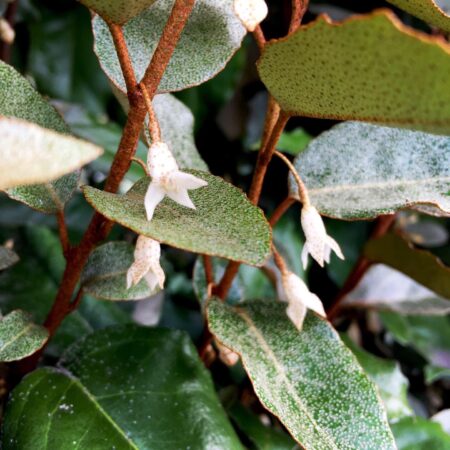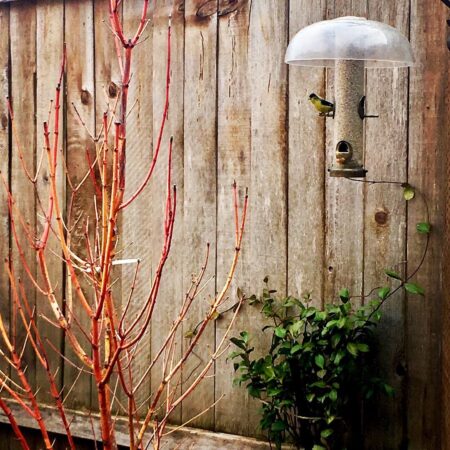Heroes, Birds, and Happiness in the Winter Garden
January 8, 2021
Heroes
If a hero is someone that saves you, then my latest hero is the writer Lia Purpura. The essays in her collection All The Fierce Tethers have been grounding, rooting, a reminder of wonder throughout this weird pandemic year. Instead of getting sucked into an anxiety-paralysis binging on news, I pick up the slim brown volume, patterned with dendrites, tributaries, branches and read:
“It looks like that tree might be her tree—where she goes to hear herself speak, tree demanding no words, but tender in the space between nose and bark (scent of pond water, cinnamon, musk)—where ants on their village roads haul their bundles in strict ordered lines. From where I’m standing, I can see her trying—how to admit those whose bodies and voices disrupt the clear ant-thoughts that touch her deep in and call her to breathe a warm safety cloud over their fear.” *
Lia’s writing is a warm safety cloud breathed over my fear of the unknowns of this past year. But more than that, she demonstrates a personal practice of deep observation. Simply stepping out your door into the garden, or even just allowing your gaze to flow there through the kitchen window as you prepare a meal, letting your attention merge with the sights, this is a kind of healing. Your nervous system cools, shoulders soften, teeth float loose at last in the steady worry of your jaw. All these benefits from looking, observing, slowing down just enough to let the beauty of nature seep in.

Winter Garden
The wintry month of January is well-suited to this kind of mild activity in the garden. Nothing to do in the frost-sparkled or mud-sodden ground but to look. What do you see out your door just now? What’s happening in the bare branches, the leaf-covered ground? Even when most plants are dormant, you’ll see the rebels, going their own way, growing leaves or even blooms full of courage in the weak January sunlight: leafy oriental poppies, cyclamen, blooming hellebores and violets. Earthworms, like stretched old chewing gum, come saturated to the surface after a rainstorm. Honeybees from the neighbors hive wake on a rare 50 degree day to find nectar in the silverberry, the viburnum, the sweet box.
When I look out the warped and weathered ninety-five year old windows above my kitchen sink on a winter morning, I see birds. All the birds at once: starlings, robins, cedar waxwings, hummingbirds, chickadees, and juncos. What a flock!
The tiny rose hips from the rambling ‘Francis E. Lester’ rose offer their gifts for all the berry eaters – waxwing, robin and yes the pest starlings. The smaller birds – bushtits, kinglets – so freakin’ cute, find tiny things only they can see. Or is it smell that draws them to the little morsels hiding in the lichen-adorned viburnum branch?
Our resident ruby flashing hummingbirds come for the sugar water in the feeder, that glass and copper beauty I got a few Christmases ago and keep regularly cleaned and filled with clear, un-dyed sugar water (proportion of 1/2 cup C&H sugar to 2 cups of water, boiled and cooled, though one of my bird savvy clients uses a stronger concentration and claims her hummers are even more joyful, as if that’s possible. Hummingbirds are better than any mood altering drug for a quick trigger to smile and shine gratitude out to the living world. )
Fall into winter blooming silverberry (Eleagnus pungens), with tiny, but insanely scented white tubes of blooms lining it’s ever-slivered branches, is as popular with the hummers as it is with the warm day waking honeybees. That and the pink dawn viburnum, which you must all know by now is my favorite shrub. Pink popcorn clusters of blooms smell cotton candy sweet, stopping covid-masked passerby in their tracks. How does the scent filter through fabric, but the virus stay out? Bees and hummingbirds share an affinity for sweet. Just like my son and I with our Christmas treats lingering, inspiring indulgence and fattening up through the cold.

Birds and Happiness
All this life, all this joy, from a kitchen window view. I read of a study recently that measured a direct increase in your happiness when there’s a higher diversity of bird species visible in your yard. In other words, more birds means more joy!
The sound of a twittering, tweeting, trilling song drew me from my computer yesterday. I went outside to see if I could identify the happy sound. In the holly tree, bird-planted along the fence line, filled only weeks ago at winter solstice with red berries and fat robins, now with only prickly leaves and a flash of olive green wing. The circular eye-ring lets me know. That song belongs to ruby-crowned kinglet! I return to my office tasks lighter and pleased to have learned the song of one of my neighbors.
How to Attract More of Both
If this doesn’t sound like an essay about gardening, don’t worry, I’m getting there. All these winter moments connecting with nature through birds doesn’t come without a little planning and mindful inclusion of certain elements in your garden designing phase.
What do you see when you put your phone down and look outside? Any birds? Where are they? What are they doing? Can you name them? How could you make room for more of these joy bringers? Here’s some ideas:
- Plant a mixed hedge
Thickets of tangled branches are the safe hideout, the nesting ground, and the resting perch for a number of songbirds. Where neighborhood cats prowl, a dense hedge is both defense and forage for sparrows, wrens, juncos and chickadees. This is an easy way to define garden boundaries, increase plant diversity with a mix of species and grow bird habitat. If the hedge is in view of a window, all the better for winter birding! - Add a fountain
Fully fluffed robins rustling in the fountain draws the whole family to the sliding glass door to see. The burbling boulder basin of fresh water holds three or more fat red breasts, lively flapping and playful splashing. Each of us breathe deeper and laugh at the sight. There’s nothing like the element of water, moving water most of all, to attract life. One of our clients even reported an owl visiting his simple water feature! - Put out feeders
The winter view from the living room window captures daydreams in the form of sparrows and juncos flitting. From feeder to fig branch, from the sheltering thicket of rambling rose-choked hedge and back to feeder again, the small birds fly like thoughts in the wind. A squirrel performs hilarious acrobatics to reach the sunflower seeds, but is thwarted by its own weight. Spring closing feeders are the way to go in squirrelville. - Leave the ground messy with leaves
Hop scratch, hop scratch, hop scratch peck. This is the dance of jay and fox sparrow alike. They forage in the duff and garden litter for tasty grubs and fallen seeds. Have you ever seen such action in the scraped and blown-off compact ground of commercial landscape beds? - Berries, hips, and fruit unharvested
Remember that huge rambling rose out my kitchen window that I talked about earlier? Best thing I’ve ever planted. ‘Francis E. Lester’ and other roses noteworthy for bearing hips, especially small hips, are a boon for robins and waxwings. Native roses, beautyberry, snowberry, crabapple and saskatoon attract admiring comments from your human and feathered friends alike. And that fruit atop your persimmon and apple tree that you couldn’t quite reach? Pretend it was an intentional offering for the birds. Or, own your laziness. Either way, the garden is livelier! - Organic always
This seems so obvious I almost forgot to mention it, but birds and all life for that matter, need you to use organic practices in your yard always. Pesticides slay song. Read this National Geographic article if you need the doom and gloom facts.

Ready to Work
My commute to work starts out the back sliding glass door. In sage green Bogs clogs, I step gingerly across the rain slicked deck, the smooth flagstone patio, up a basalt stair and through the winter dormant meadow, then around to the gate between our backyard and the neighbor’s. On that side, I traverse one more slippery deck and enter the light-filled studio that I rent from friends. I’ve arrived at the office. The magic of this brief commute comes from the awakening, the brightening of mood, the wonder of jay foraging in leaf debris, Bewick’s wren zipping from mossy lilac to thin-skinned fig branch, chickadee in stark black-white-black helmet, and red-breasted sapsucker head-banging for its breakfast. Carrying with me the beauty words of my hero, Lia Purpura from my morning reading over tea, I’m ready to work, to create more of these moments for you in your garden.
Tell me who your hero is or what’s sparking joy from your garden lately. Leave a comment below.
*from Lia Purpura’s essay On Photographing Children in Trees published in the collection All The Fierce Tethers page 13.

Lovely piece of writing. So inspiring! I’m intrigued about that silverberry!
Thanks for reading! You’ll love silverberry. It gets big, like 8’+ so give it space, somewhere where you’ll catch its scent on the wind in fall and winter.